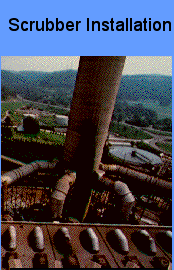Acid rain describes any form of rainfall with high levels of nitric and sulfuric acids. It can also occur in the form of snow, fog, and tiny bits of dry material that settle to Earth.
Acid rain is mostly caused by human activities. The biggest culprit is the burning of fossil fuels by coal-burning power plants, factories, and automobiles.
When humans burn fossil fuels, sulfur dioxide (SO2) and nitrogen oxides (NOx) are released into the atmosphere. These chemical gases react with water, oxygen, and other substances to form mild solutions of sulfuric and nitric acid
SO2 (g) + H2O ========> H2SO4
NO2(g) + H2O ========> HNO3
Winds may spread these acidic solutions across the atmosphere and over hundreds of miles. When acid rain reaches Earth, it flows across the surface in runoff water, enters water systems, and sinks into the soil.
Effects
Acid rain has many ecological effects, but none is greater than its impact on lakes, streams, wetlands, and other aquatic environments. Acid rain makes waters acidic and causes them to absorb the aluminum that makes its way from soil into lakes and streams. This combination makes waters toxic to crayfish, clams, fish, and other aquatic animals.
Some species can tolerate acidic waters better than others. However, in an interconnected ecosystem, what impacts some species eventually impacts many more throughout the food chain—including non-aquatic species such as birds.
Acid rain also damages forests, especially those at higher elevations. It robs the soil of essential nutrients (such as Calcium) and releases aluminum in the soil, which makes it hard for trees to take up water. Trees' leaves and needles are also harmed by acids.
The effects of acid rain, combined with other environmental stressors, leave trees and plants less able to withstand cold temperatures, insects, and disease. The pollutants may also inhibit trees' ability to reproduce. Some soils are better able to neutralize acids than others. In areas where the soil's "buffering capacity" is low, the harmful effects of acid rain are much greater.
Since acid rain can kill aquatic animals, weaken trees and dissolve stone, it seems like it could also scald or burn humans. But it doesn't affect people in the same way as it does fish or plants. Acid rain feels the same as regular rain -- it's even safe to swim in an acidic lake. But the sulphate and nitrate particulates of dry deposition can cause asthma, cough and heart problems. The NOx in acid deposition also reacts with volatile organic compounds (VOCs) to form ground-level ozone. Ozone, or smog, aggravates and weakens the respiratory system.
Also acid rain has the unsettling ability to erase and obliterate stone and metal, the most durable of materials. Old buildings, monuments and tombstones bear the smooth signs of acidic corrosion and deterioration. Acid deposition speeds up natural weathering caused by rain, sun, snow and wind.
Acid rain also mars automotive paint. The auto industry considers acid deposition one type of corrosive environmental fallout, along with tree sap, pollen and bird droppings. Acid markings leave irregular, etched shapes on horizontal surfaces. Repainting is the only way to fix a car finish disfigured by acid rain
Solutions
The only way to fight acid rain is by curbing the release of the pollutants that cause it. This means burning fewer fossil fuels. But that is going to mean a lot of economical setbacks for some countries, especially developing countries. Also for developed countries; it could mean a total turnaround from how things used to be done. That leaves a very big question; is there a practical way to stop acid rain? There is none, however there are practical methods to stop the production of gases that cause acid rain.
Some very interesting innovations have been applied in the coal mining industry - a major source for SO2 and NOx. Methods being used includes:
Use Scrubbers:
Scrubbers are like "liquid" filters for the gases resulting from combustion. The exhaust gases are forced through a spray of water containing lime (calcium hydroxide). The sulphur dioxide gas reacts with the lime to produce a solid of calcium sulphate.
SO2 + Ca(OH)2 =======> CaSO4 + H2O
Scrubbers remove 80-95 percent of the sulfur oxides. Certain types do not remove nitrogen oxides. They are costly to retrofit to existing power plants. They increase the electric generating costs by 10-15 %.
There are then problems in getting rid of the liquid sludge that is produced. Usually the sludge is poured into a lake for temporary storage. Moreover it’s a very important industrial chemical with various uses.
It is worthy of note that the installation of scrubbers comes with a cost especially when it is being imbibed on an existing plant, but the environmental costs of inadequately controlled emissions are also large.


